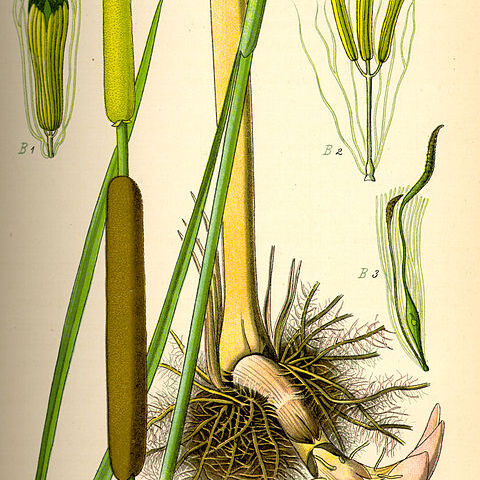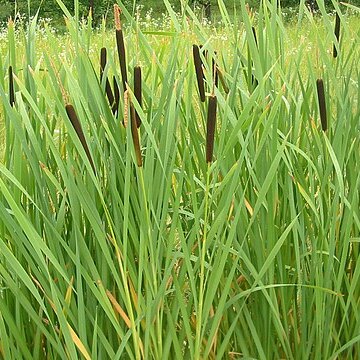Perennial, palustrial or aquatic herbs with a creeping rhizome; stems erect, solid, submerged at the base. Leaves biseriate, partly radical or subradical, partly cauline, lower congested, higher remote, elongate-linear, rather thick and spongy, blunt-margined; their sheathing bases excreting slime on their inner side. Flowers very numerous, very closely packed in 2 or less often 3, superposed, contiguous or more or less remote terete unisexual spikes; upper spike male; the 1-2 lower ♀; all spikes at the base with a foliaceous bract which falls off long before anthesis; the ♀ spikes here and there between the flowers often with a similar bract. ♂ Flowers consisting of 3 flat hairs together surrounding 2-5 stamens; anthers basifixed, linear, 2-celled; connective shortly produced; cells back to back, bursting longitudinally; pollen-grains free or cohering in tetrads. Rachis of ♀ spathe closely studded with patent cylindrical thickish excrescences; between these excrescences and on their basal part beset with flowers containing a fertile ovary; higher part of the excrescences bearing rudimentary ovaries. ♀ Flowers with or without a very narrow bracteole; bracteole with a more or less broadened, often dentate-acuminate apex either entirely hidden by the flowers or their apex visible externally. Ovary borne by a long very thin stalk (gynophore) which bears long hairs on its base, fusiform, 1-celled; style distinct thin; stigma broadened, unilateral, linear or spathulate. Fruit small, fusiform, or elongate-ovoid, falling off together with its stalk from the pilose axis of the spike, finally bursting by a longitudinal slit; seed pendulous, striate; endosperm mealy; embryo narrow, straight, nearly as long as the seed.
Stout glabrous marsh herbs with sympodial branched rhizomes covered by distichous cataphylls and having terminal erect shoots. Lower leaves transitional, short-bladed; upper leaves with a long sheath closely enveloping the stem, often auricled at the junction with the blade, and a linear obtuse or acute blade gradually widening from a narrow subpetiolar base, semi-cylindric to lenticular in section, sometimes keeled beneath. Male inflorescence apical, dense; flowers reduced to a pedicellate group of 2–4(–7) stamens with the filaments fused below; anthers dithecous, oblong, with the connective produced above; bracteoles filiform, spathulate or spathulate-laciniate; pollen grains shed singly or in tetrads. Female inflorescence a single spike beneath the ♂, remote from it or contiguous, rarely with 1 or 2 additional ♀ spikes remote from each other beneath the first; flowers with the perigonous hairs and bracteoles of similar length, the styles conspicuously longer; bracteoles filiform, broadening into an expanded ovate or spathulate lamina; carpodia about as long as the bracteoles. Follicle narrowly ellipsoid; seed fusiform.
Herbs, perennial, in marshes or aquatic, with creeping rhizomes. Leaves alternate, erect, distichous, linear, usually spongy, margin entire, sheathed at base. Flowers unisexual, minute, numerous, densely crowded in a cylindric spike with lower part female and upper part male; bracts leaflike. Perianth absent. Male flowers consisting of 1-3 stamens usually connate at base of filaments, surrounded by hairs; anthers 2-thecous, basifixed, longitudinally dehiscent; filaments short; pollen grains in monads or tetrads. Female flowers: ovary 1-loculed, on a long capillary stalk with many fine hairs or bracteoles at base; styles capillary; stigmas broadened or spatulate; ovule 1; sterile ovary without style. Fruit minute, falling off together with stalk.
Massive semiaquatic perennial herbs with extensive fleshy rhizomes. Leaves elongate, flat, equitant. Flowering stems elongate, terete; flowers monoecious, very numerous in two adjacent dense, cylindric spikes, the staminate above the pistillate, each usually subtended by a reduced, spathe-like leaf; perianth reduced to bristles or hairs; ovary stipitate, 1-2-celled.
Characters of the family. 10, cosmop.
Characters as for the family.
See Typhaceae.


